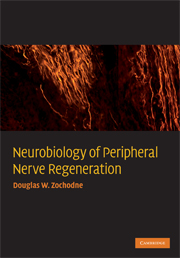Book contents
- Frontmatter
- Contents
- Acknowledgments
- 1 Introduction
- 2 The intact peripheral nerve tree
- 3 Injuries to peripheral nerves
- 4 Addressing nerve regeneration
- 5 Early regenerative events
- 6 Consolidation and maturation of regeneration
- 7 Regeneration and the vasa nervorum
- 8 Delayed reinnervation
- 9 Trophic factors and peripheral nerves
- 10 The nerve microenvironment
- References
- Index
- Plate section
- References
7 - Regeneration and the vasa nervorum
- Frontmatter
- Contents
- Acknowledgments
- 1 Introduction
- 2 The intact peripheral nerve tree
- 3 Injuries to peripheral nerves
- 4 Addressing nerve regeneration
- 5 Early regenerative events
- 6 Consolidation and maturation of regeneration
- 7 Regeneration and the vasa nervorum
- 8 Delayed reinnervation
- 9 Trophic factors and peripheral nerves
- 10 The nerve microenvironment
- References
- Index
- Plate section
- References
Summary
Peripheral nerves are living dynamic tissues that thrive on a nutritive blood supply. The vascular supply of the peripheral nerve, termed “vasa nervorum” participates intimately in regenerative events and influences their success. There are important morphological and physiological differences among microvessels that supply nerve trunk, ganglia, and brain. Each entrains and regulates its vascular supply from differing physiological perspectives, depending on their need for metabolic support. Following injury, vasa nervorum alter their behavior in unique ways that reflect their exposure to molecules released within the microenvironment and that offer insights into the repair process.
Blood flow and microvessels of intact nerve trunks
Nerve trunk blood vessels, or vasa nervorum, are supplied by upstream arterial branches of major limb vessels. Sometimes these arteries and nerves course together as neurovascular bundles. Peripheral nerves also share their abundant blood supply with other structures in limbs such as bone, connective tissue, skin, and muscle. For this reason, major ischemic lesions are likely to target several tissues and cause widespread damage. The redundant and abundant blood suppy of nerve trunks, however, can be advantageous because the interruption of a single artery is unlikely to cause significant ischemia. There are some sites where there is ischemic vulnerability, known as watershed zones. These are found at areas supplied by terminal branches of overlapping arterial trees. For example, a nerve watershed zone has been identified in the proximal tibial nerve of rats [458].
- Type
- Chapter
- Information
- Neurobiology of Peripheral Nerve Regeneration , pp. 153 - 169Publisher: Cambridge University PressPrint publication year: 2008



